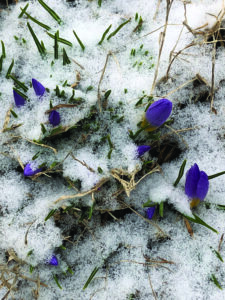
Every January a small clump of snow crocus blooms, starting out by revealing a little bit of pale lavender-colored flowers cupped in the nest of thin dark green leaves. (Photo by Ginny Rosenkranz)
There are some surprises in the gardens during this chilly time of the year, and one is the emergence of a very hardy and rather small plant, the Crocus tommasinianus or the snow crocus.
Every January in my yard a small clump of snow crocus blooms, starting out by just revealing a little bit of their pale lavender-colored flowers cupped in the nest of thin dark green leaves.
If the days remain cold and cloudy the flowers remain closed, but if the sun shines the bowl-shaped flowers open showing off their lavender to reddish purple petals, a white throat and bright orange stigmas full of pollen.
Despite the cold weather this tiny crocus welcomes any of the hardiest of pollinators.
As the sun sets the flowers close again to wait for another sunny day.
Crocus are corms, and should be planted in well drained sandy soils in the fall, about 3-4 inches deep and about 3-6 inches apart.
They will come up every winter to brighten the landscape and thrive along paths and walkway, under deciduous trees and in front of shrubs.
They can also be planted in large or small groups into the lawns where they will bloom year after year.
By the time it is warm enough to cut the grass, these tiny crocuses will have gone dormant and will not be in the way of the mowers.
Once the plants are established, they can naturalize by creating offsets, expanding each of the clumps a bit each year.
They can also self-seed which can create lovely colorful drifts over time.
Best of all, the snow crocus is not a meal for deer or squirrels, and can live under the shade of the Black Walnut.
It is nice to know that even in the coldest months there is still beauty to be found in our landscapes.
(Editor’s Note: Ginny Rosenkranz is a commercial horticulture specialist with the University of Maryland Extension.)



